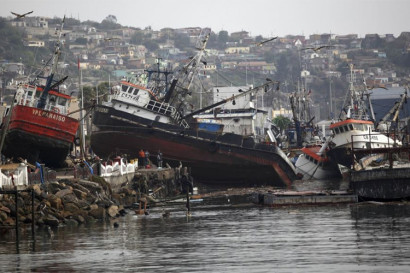Faster, more accurate tsunami warnings with GPS
Instruments already in place around the world could allow nearly 20 minutes more to evacuate coastal areas, UC Berkeley seismologists report.
February 16, 2016
GPS instruments already in place around the world could provide more rapid and more accurate warning of a tsunami, allowing nearly 20 minutes more to evacuate coastal areas, UC Berkeley seismologists report.

Ships tossed around by a tsunami that struck the city of Coquimbo, Chile, after an 8.3-magnitude earthquake on Sept. 18, 2015. AP photo.
Current early-warning systems rely on networks of seismometers and can take more than 20 minutes to estimate the severity of an earthquake and the likely wave height of a tsunami.
After last year’s 8.3-magnitude Illapel quake in Chile, for example, the government took 16 minutes to issue an evacuation order that eventually involved a million people. The first estimate of the wave’s height – 9 feet – was not issued until 31 minutes after the quake. The UC Berkeley researchers estimate that by analyzing GPS signals, which show how much the earth slipped, they could have provided information on expected wave height within five minutes of the quake.
“This isn’t a deployment of new instruments, just a change in thinking and using these instruments,” said Diego Melgar, a research scientist at the Berkeley Seismological Laboratory and lead author of the new study. “Our results show that with what people have now, at geophysical monitoring agencies everywhere in the world, people can do this.”
Melgar and colleagues at UC Berkeley, including seismology lab director Richard Allen, summarized their study in a paper accepted for publication in the journal Geophysical Research Letters.
The UC Berkeley researchers examined four recent tsunami-generating earthquakes in Japan and Chile and determined that a GPS system could generate a tsunami warning map within one to two minutes after the beginning of the earthquake. Information about the estimated height of tsunami waves took less than two additional minutes to compute.
The UC Berkeley approach does not require deployment of new geodetic and seismic instrumentation in many subduction zones and could be implemented rapidly by national monitoring and warning agencies, the researchers say.
For more details about the research, which was funded by a grant from the Gordon and Betty Moore Foundation, link to a summary on the American Geophysical Union website.